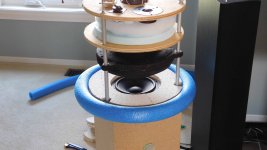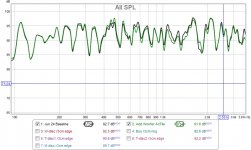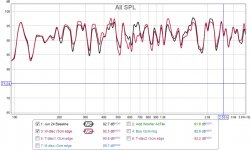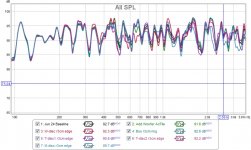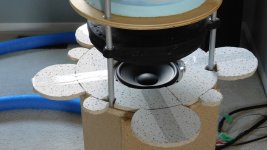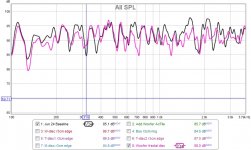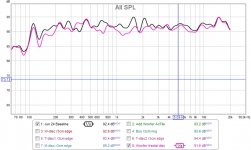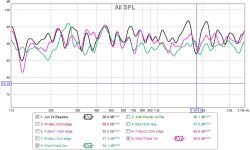I am starting to warm up to REW. I used ARTA before because I like the pink noise based FR graphs, as it gets all of the speaker working at once like music. REW's swept sine seems to have an edge when trying to isolate issues. Interestingly the two methods provide very close FR results.
I'm finding REW has a lot of great features. In particular the EQ section and filter export. I was using it with EqualizerAPO's convolution engine to try reducing the diffraction effects. It was better at the mic, but didn't work for the rest of the room
I'm finding REW has a lot of great features. In particular the EQ section and filter export. I was using it with EqualizerAPO's convolution engine to try reducing the diffraction effects. It was better at the mic, but didn't work for the rest of the room
Diffraction - rounding the edges
It's another set of experiments and I'm trying to calm the ripple. This time I'm seeing what the edge profile effect is. Normally its good practice to round the corners and edges to reduce diffraction. How effective is that?
My baffles are 2cm thick particle board, so you could realistically only get a 1cm radius edge profile. I've exaggerated the effect by adding a foam 3cm radius edge to the baffle. This should provide a more exaggerated effect that I should be able to see. Again I'm primarily concerned with the woofer at this point. Well,... it makes very little difference.
The pics#1 below show how large the radius is, clearly exaggerated. Pic#2 show the comparative effect (very little) of adding the acoustic tile to the woofer baffle. Pic#3 show the comparative effect (very little) of adding the large radius edge to the baffle. Pic #4 show many different edge treatments on different baffles and the effect is minimal. Also notice the frequencies (peaks and nulls) did not change, only minor changes in amplitude.
It's another set of experiments and I'm trying to calm the ripple. This time I'm seeing what the edge profile effect is. Normally its good practice to round the corners and edges to reduce diffraction. How effective is that?
My baffles are 2cm thick particle board, so you could realistically only get a 1cm radius edge profile. I've exaggerated the effect by adding a foam 3cm radius edge to the baffle. This should provide a more exaggerated effect that I should be able to see. Again I'm primarily concerned with the woofer at this point. Well,... it makes very little difference.
The pics#1 below show how large the radius is, clearly exaggerated. Pic#2 show the comparative effect (very little) of adding the acoustic tile to the woofer baffle. Pic#3 show the comparative effect (very little) of adding the large radius edge to the baffle. Pic #4 show many different edge treatments on different baffles and the effect is minimal. Also notice the frequencies (peaks and nulls) did not change, only minor changes in amplitude.
Attachments
Diffraction - changing the perimeter
According to the Linkwitz experiments on diffraction, symmetric perimeters are worse than asymmetric. A conventional speaker uses a rectangular baffle. Diffraction is still occurring, but its FR looks better because the distance from the driver center to the baffle edge varies as you move along the edge. This spreads out the diffraction instead of having defined peaks and nulls like you get from a symmetric baffle.
There are a few options that allow a) varying the distance from driver to edge, and b) keep avg polar symmetry. Fractals come to mind, like the Mandelbrot, or Koch snowflake. Again, I have used an exaggerated perimeter to see the effect. I want to remove local symmetry but keep global symmetry to allow diffraction to spread out in frequency to avoid such clearly defined peaks and nulls. Ideally the geometry used would align alternate peaks and nulls to offset each other using "diffraction to fight diffraction". Again, I'm only trying this for the woofer baffle.
Pic#1 shows the exaggerated perimeter to see if I can spread out the peaks and nulls. Pic#2 show the comparison, clearly this works because the amplitudes reduced and frequency have shifted. Pic#3 showed a more smoothed 1/6 FR just for comparisons.
Next,.. new perimeters after I do some math.
According to the Linkwitz experiments on diffraction, symmetric perimeters are worse than asymmetric. A conventional speaker uses a rectangular baffle. Diffraction is still occurring, but its FR looks better because the distance from the driver center to the baffle edge varies as you move along the edge. This spreads out the diffraction instead of having defined peaks and nulls like you get from a symmetric baffle.
There are a few options that allow a) varying the distance from driver to edge, and b) keep avg polar symmetry. Fractals come to mind, like the Mandelbrot, or Koch snowflake. Again, I have used an exaggerated perimeter to see the effect. I want to remove local symmetry but keep global symmetry to allow diffraction to spread out in frequency to avoid such clearly defined peaks and nulls. Ideally the geometry used would align alternate peaks and nulls to offset each other using "diffraction to fight diffraction". Again, I'm only trying this for the woofer baffle.
Pic#1 shows the exaggerated perimeter to see if I can spread out the peaks and nulls. Pic#2 show the comparison, clearly this works because the amplitudes reduced and frequency have shifted. Pic#3 showed a more smoothed 1/6 FR just for comparisons.
Next,.. new perimeters after I do some math.
Attachments
The pattern has definitely made some worthwhile improvement to the bigger dips.
I wonder if the acoustic tile creates a new baffle or if the baffle is still the particle board and the tile acts in a similar way to felt placed around the driver?
One thing you could consider (although it would be a rebuild of your cabinet) is to inset the woofer into a bowl shape and use a pipe for the volume of the enclosure.
Bushmeister has shown some significant improvement in his mid dome used in an Ikea bowl enclosure in the Great balls of prestige thread.
It is also a pretty nice overall finish too.
I wonder if the acoustic tile creates a new baffle or if the baffle is still the particle board and the tile acts in a similar way to felt placed around the driver?
One thing you could consider (although it would be a rebuild of your cabinet) is to inset the woofer into a bowl shape and use a pipe for the volume of the enclosure.
Bushmeister has shown some significant improvement in his mid dome used in an Ikea bowl enclosure in the Great balls of prestige thread.
It is also a pretty nice overall finish too.
The pattern has definitely made some worthwhile improvement to the bigger dips.
I wonder if the acoustic tile creates a new baffle or if the baffle is still the particle board and the tile acts in a similar way to felt placed around the driver?
I did measure with and without the acoustic tile as I though reflections were occurring between the woofer chamber and first cone via the woofer membrane. It seems very little of this is going on. Adding the tile made very little difference. I would think the first surface is the baffle, in this case it would be the tile. Adding a tile, reduces the area but it does not make much difference (its pic#2 in the baffle radius set).
One thing you could consider (although it would be a rebuild of your cabinet) is to inset the woofer into a bowl shape and use a pipe for the volume of the enclosure.
Bushmeister has shown some significant improvement in his mid dome used in an Ikea bowl enclosure in the Great balls of prestige thread.
It is also a pretty nice overall finish too.
At this point the project is just a sandbox used to find a solution. I'm willing to change everything, as this enclosure is only $13 CDN of particle board. Once I have a solution I will build something less monstrous, and yes the entire speaker will be cylindrical.
Last edited:
If the acoustic tile is the baffle then it might make more sense to have the woofer flush with it or as a test make the transition less sharp on the inside to see if it helps. If some of the diffraction is coming from the upper drivers you could try some felt on the baffle around the woofer too.
Have you measured at different distances?
I measured my line array outside with felt or no felt on the edges of the baffle to see how it affected diffraction.
At 1m it did make a difference in the 4K range but by 3m the results were almost identical.
Part of that could be that it took that distance for all the drivers to combine due to the length of the line.
Have you measured at different distances?
I measured my line array outside with felt or no felt on the edges of the baffle to see how it affected diffraction.
At 1m it did make a difference in the 4K range but by 3m the results were almost identical.
Part of that could be that it took that distance for all the drivers to combine due to the length of the line.
Last edited:
Interesting design with the fractal, almost flower like. Has anyone made an open baffle like this with a full range?
I've seen a few variations on the LX-Mini with some baffle on the full ranger but nothing this dramatic.
It's a very exaggerated shape for the test, but it will have a finer degree of self-symmetry in the next version.
If you have a non symmetric shape like a columnar box with rectangular baffle, its probably sufficient already for a full range. Although for open baffle designs like the LX it might be helpful but only if the baffle was large.
The shape looks like something that should be on the side of a modern hippie van
If the acoustic tile is the baffle then it might make more sense to have the woofer flush with it or as a test make the transition less sharp on the inside to see if it helps.
Have you measured at different distances?
I have not measured at different distances, Hmm,.... that would be a good idea, thanks. I usually stick to this 1m position because its the only place that I can partially isolate the speaker. The acoustic tile on top of the woofer is likely to go, it makes too little difference.
I measured my line array outside with felt or no felt on the edges of the baffle to see how it affected diffraction.
At 1m it did make a difference in the 4K range but by 3m the results were almost identical.
Part of that could be that it took that distance for all the drivers to combine due to the length of the line.
I've always wondered about LA measurements. When you're near field, the distance to each driver is different so it suggests you would get a blurred FR average. Kinda averaging the grass.
I'm not surprised that felt on the edges made little difference.
I've always wondered about LA measurements. When you're near field, the distance to each driver is different so it suggests you would get a blurred FR average. Kinda averaging the grass.
Measurements are here if you want to see
http://www.diyaudio.com/forums/full-range/303417-full-range-tc9-line-array-cnc-cabinet-42.html#post5089245
The difference with distance isn't huge, the 400 to 600Hz area and the comb filtering point changes but the overall response is fairly consistent.
You can see some difference in the un-smoothed graphs, I wasn't expecting too much as there is not a lot of felt but I was a little surprised to see that with distance the effect virtually vanished.I'm not surprised that felt on the edges made little difference.
Measurements are here if you want to see
http://www.diyaudio.com/forums/full-range/303417-full-range-tc9-line-array-cnc-cabinet-42.html#post5089245
The difference with distance isn't huge, the 400 to 600Hz area and the comb filtering point changes but the overall response is fairly consistent.
You can see some difference in the un-smoothed graphs, I wasn't expecting too much as there is not a lot of felt but I was a little surprised to see that with distance the effect virtually vanished.
Thanks for the link. I read several pages, there's lot there. I don't see a good argument for felt either.
Have you measured at different distances?
I tried a 2m measurement, but I needed to change position, it's 135 deg from my other measuring position. There is some attenuation from distance, and room action, but it looks very similar. I have used 1/12 smoothing to make it less busy with 3 curves. The ripple is still there.
Attachments
The main purpose of the felt was always to keep the fabric cover away from the cones. I had hoped it would at least not make things worseThanks for the link. I read several pages, there's lot there. I don't see a good argument for felt either.
I have seen other results that showed a bigger change but they used more felt and perhaps were used with cabinets that had a higher level of diffraction than mine.
It does look to have reduced the peaks in the lower midrange which is a good thing even if the measurement is not ideal.I tried a 2m measurement, but I needed to change position, it's 135 deg from my other measuring position. There is some attenuation from distance, and room action, but it looks very similar. I have used 1/12 smoothing to make it less busy with 3 curves. The ripple is still there.
I was thinking that... a big flowery face for my OB Jordans, not sure I could handle the aesthetics though, haha.Interesting design with the fractal, almost flower like. Has anyone made an open baffle like this with a full range?
Hi Don, I'm still here watching...very interesting work...did wonder where you had got too..
I was thinking that... a big flowery face for my OB Jordans, not sure I could handle the aesthetics though, haha.
There are simpler ways to make a baffle
Hi Don, I'm still here watching...very interesting work...did wonder where you had got too..
I needed a short break for family projects that took up most of the last 6wks.
With these latest Omni V3 changes I am getting very close to a solution.
I really like this thread and enjoy seeing your work and your excellent documentation of it.  Sometimes I wish the thread got more comments, other times it's nice that it doesn't, so that it stays focused.
Sometimes I wish the thread got more comments, other times it's nice that it doesn't, so that it stays focused.
Agree about REW. I used ARTA and HOLMImulse so much that REW took awhile to warm up to. But it really does do a good job, and is getting better all the time. You might want to peek into the rePhase thread - it's a long one. Mostly because of the thread, REW now has a rePhase filter function. Super handy.
http://www.diyaudio.com/forums/mult...on-eq-fir-filtering-tool-209.html#post5116511
 Sometimes I wish the thread got more comments, other times it's nice that it doesn't, so that it stays focused.
Sometimes I wish the thread got more comments, other times it's nice that it doesn't, so that it stays focused.Agree about REW. I used ARTA and HOLMImulse so much that REW took awhile to warm up to. But it really does do a good job, and is getting better all the time. You might want to peek into the rePhase thread - it's a long one. Mostly because of the thread, REW now has a rePhase filter function. Super handy.
http://www.diyaudio.com/forums/mult...on-eq-fir-filtering-tool-209.html#post5116511
I really like this thread and enjoy seeing your work and your excellent documentation of it.Sometimes I wish the thread got more comments, other times it's nice that it doesn't, so that it stays focused.
Thanks, its always good to have others interested in the project.
Agree about REW. I used ARTA and HOLMImulse so much that REW took awhile to warm up to. But it really does do a good job, and is getting better all the time. You might want to peek into the rePhase thread - it's a long one. Mostly because of the thread, REW now has a rePhase filter function. Super handy.
http://www.diyaudio.com/forums/mult...on-eq-fir-filtering-tool-209.html#post5116511
I actually use EqualizerAPO for both the equalizer and the convolution engine. I've been using REW's equalizer (IIR based) to export wavefiles for APO's convolution engine. Rephase is next on my list as I would like to use the FIR capability. That link will be helpful, thanks.
I actually use EqualizerAPO for both the equalizer and the convolution engine. I've been using REW's equalizer (IIR based) to export wavefiles for APO's convolution engine. Rephase is next on my list as I would like to use the FIR capability. That link will be helpful, thanks.
When you investigate FIR filtering have a look at the DRC program too. While it was conceived as a room correction program it can also be used more as a fine grained speaker correction tool depending on the parameters used.
There is a thread where gmad has provided a package which includes ready made scripts, you could use the correction files with the convolution part of Equalizer APO.
http://www.diyaudio.com/forums/full-range/275730-convolution-based-alternative-electrical-loudspeaker-correction-networks.html
If you get the latest beta of REW it has the ability to time align and vector average a set of measurements, by taking multiple measurements around your entire listening area and averaging them there is much less chance of overcorrection and the sound changing considerably over distance.
There is a guide in the most recent post in the rephase thread.
When you investigate FIR filtering have a look at the DRC program too. While it was conceived as a room correction program it can also be used more as a fine grained speaker correction tool depending on the parameters used.
There is a thread where gmad has provided a package which includes ready made scripts, you could use the correction files with the convolution part of Equalizer APO.
http://www.diyaudio.com/forums/full-range/275730-convolution-based-alternative-electrical-loudspeaker-correction-networks.html
Thanks for the references, I'll look into them.
If you get the latest beta of REW it has the ability to time align and vector average a set of measurements, by taking multiple measurements around your entire listening area and averaging them there is much less chance of overcorrection and the sound changing considerably over distance.
There is a guide in the most recent post in the rephase thread.
I have REW 5.19B and will update it after I fix this diffraction issue. Then I can focus on FIR, phase and IR issues. The idea of averaging the room measurement is very appealing, especially since an Omni uses the entire room
- Home
- Loudspeakers
- Multi-Way
- OmniDirectional - work in progress
